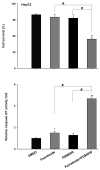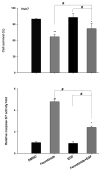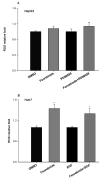ERK1/2 deactivation enhances cytoplasmic Nur77 expression level and improves the apoptotic effect of fenretinide in human liver cancer cells
- PMID: 21241664
- PMCID: PMC3059345
- DOI: 10.1016/j.bcp.2011.01.005
ERK1/2 deactivation enhances cytoplasmic Nur77 expression level and improves the apoptotic effect of fenretinide in human liver cancer cells
Abstract
Fenretinide, a synthetic retinoid, is a promising anticancer agent based on many in vitro, animal, and chemoprevention clinical trial studies. However, cells such as HepG2 human liver cancer cells are resistant to the apoptotic effect of fenretinide. Previously, we have shown that fenretinide-induced apoptosis is Nur77 dependent, and the sensitivity of the cancer cells to fenretinide-induced apoptosis is positively associated with cytoplasmic enrichment of Nur77. The goal of current study was to identify means to modulate nuclear export of Nur77 in order to improve the efficacy of fenretinide. Fenretinide treatment deactivated ERK1/2 in Huh7 cells, but activated ERK1/2 in HepG2 cells, which was positively associated with the sensitivity of cells to the apoptotic effect of fenretinide. Neither fenretinide nor ERK1/2 inhibitor PD98059 alone could affect the survival of HepG2 cells, but the combination of both induced cell death and increased caspase 3/7 activity. In fenretinide sensitive Huh7 cells, activation of ERK1/2 by epidermal growth factor (EGF) prevented fenretinide-induced cell death and caspase 3/7 induction. In addition, modulation of ERK1/2 changed the intracellular localization of Nur77. Fenretinide/PD98059-induced cell death of HepG2 cell was positively associated with induction and cytoplasmic location as well as mitochondria enrichment of Nur77. The effect was specific for ERK1/2 because other mitogen activated protein kinases such as P38, Akt, and JNK did not have correlated changes in their phosphorylation levels. Taken together, the current study demonstrates that ERK1/2-modulated Nur77 intracellular location dictates the efficacy of fenretinide-induced apoptosis.
Copyright © 2011 Elsevier Inc. All rights reserved.
Figures








Similar articles
-
Induction and intracellular localization of Nur77 dictate fenretinide-induced apoptosis of human liver cancer cells.Biochem Pharmacol. 2010 Apr 1;79(7):948-54. doi: 10.1016/j.bcp.2009.11.004. Epub 2009 Nov 11. Biochem Pharmacol. 2010. PMID: 19912993 Free PMC article.
-
Enrichment of Nur77 mediated by retinoic acid receptor β leads to apoptosis of human hepatocellular carcinoma cells induced by fenretinide and histone deacetylase inhibitors.Hepatology. 2011 Mar;53(3):865-74. doi: 10.1002/hep.24101. Epub 2011 Feb 11. Hepatology. 2011. PMID: 21319187 Free PMC article.
-
Induction of Nur77-dependent apoptotic pathway by a coumarin derivative through activation of JNK and p38 MAPK.Carcinogenesis. 2014 Dec;35(12):2660-9. doi: 10.1093/carcin/bgu186. Epub 2014 Sep 3. Carcinogenesis. 2014. PMID: 25187486 Free PMC article.
-
Regulation of Nur77 nuclear export by c-Jun N-terminal kinase and Akt.Oncogene. 2006 May 18;25(21):2974-86. doi: 10.1038/sj.onc.1209358. Oncogene. 2006. PMID: 16434970
-
Mechanisms of fenretinide-induced apoptosis.Apoptosis. 2006 Oct;11(10):1677-94. doi: 10.1007/s10495-006-9289-3. Apoptosis. 2006. PMID: 16850162 Review.
Cited by
-
Modulation of the Nur77-Bcl-2 apoptotic pathway by p38α MAPK.Oncotarget. 2017 Jul 13;8(41):69731-69745. doi: 10.18632/oncotarget.19227. eCollection 2017 Sep 19. Oncotarget. 2017. PMID: 29050237 Free PMC article.
-
Design, synthesis, and evaluation of novel benzoylhydrazone derivatives as Nur77 modulators with potent antitumor activity against hepatocellular carcinoma.J Enzyme Inhib Med Chem. 2023 Dec;38(1):2227777. doi: 10.1080/14756366.2023.2227777. J Enzyme Inhib Med Chem. 2023. PMID: 37357764 Free PMC article.
-
Controversy and multiple roles of the solitary nucleus receptor Nur77 in disease and physiology.FASEB J. 2025 Mar 31;39(6):e70468. doi: 10.1096/fj.202402775RR. FASEB J. 2025. PMID: 40079203 Free PMC article. Review.
-
12-Deacetyl-12-epi-Scalaradial, a Scalarane Sesterterpenoid from a Marine Sponge Hippospongia sp., Induces HeLa Cells Apoptosis via MAPK/ERK Pathway and Modulates Nuclear Receptor Nur77.Mar Drugs. 2020 Jul 21;18(7):375. doi: 10.3390/md18070375. Mar Drugs. 2020. PMID: 32708154 Free PMC article.
-
Bile acids regulate nuclear receptor (Nur77) expression and intracellular location to control proliferation and apoptosis.Mol Cancer Res. 2015 Feb;13(2):281-92. doi: 10.1158/1541-7786.MCR-14-0230. Epub 2014 Sep 17. Mol Cancer Res. 2015. PMID: 25232032 Free PMC article.
References
-
- Moon RC, Mehta RG. Chemoprevention of experimental carcinogenesis in animals. Prev Med. 1989;18:576–91. - PubMed
-
- Hail N, Jr, Kim HJ, Lotan R. Mechanisms of fenretinide-induced apoptosis. Apoptosis. 2006;11:1677–94. - PubMed
-
- Wu JM, DiPietrantonio AM, Hsieh TC. Mechanism of fenretinide (4-HPR)-induced cell death. Apoptosis. 2001;6:377–88. - PubMed
-
- Sogno I, Vene R, Ferrari N, De Censi A, Imperatori A, Noonan DM, et al. Angioprevention with fenretinide: targeting angiogenesis in prevention and therapeutic strategies. Crit Rev Oncol Hematol. 2010;75:2–14. - PubMed
Publication types
MeSH terms
Substances
Grants and funding
LinkOut - more resources
Full Text Sources
Medical
Research Materials
Miscellaneous

